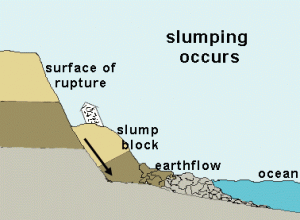Mass movement & Ground Water
Mass movement
- Movement of weathered material down the slope due to gravitational force
- Movement may be gradual or sudden depending on the gradient of the slope, weight of the weathered debris & presence of a lubricating agent such as water
Soil Creep
-
- Slow & gradual but more or less continuous movement of soil down the hill slopes
- Movement is not very noticeable, especially when slope is fairly gentle or when soil is well covered with grass or other vegetation
- Most common in damp soils where water act as a lubricant so that individual soil particles move over each other & over the underlying rock

- Though the movement is slow, the gradual movement tilts trees, fences, posts & so on which are rooted in the soil
- Soil is also seen to accumulate at the foot of the slope or behind obstacles such as walls, which may burst by weight of the soil accumulated
Soil Flow / Mud Flow (Solifluction)
-
- When the soil is completely saturated with water, soil particles easily move over each other & over the underlying rock

- Soil act as a liquid mixture & soil flow or mud flow occur
- In Ireland such flows are known as Bog-Burst
Landslide (Slumping or Sliding)
- Very rapid movements resulting in large mass of soil & rock falling suddenly
- Landslide usually occurs on steep slopes & by earthquakes & volcanic activities
- Landslides are often caused by the lubricating action of rain water
- Slumping is usually common where permeable debris or rock layer overlie impermeable strata such as clay
- Water sinking through the permeable layer is halted by the clay
- Damp clay provides a smooth slippery surface over which the upper layers slides easily
- Man often enhances the possibility of landslide by clearing natural vegetation for agriculture & housing which allows more water to penetrate through soil & rocks


Groundwater
-
- When rain falls on earth it is distributed in various ways.
- Some is immediately evaporated & thus returned to atmosphere as water vapour.
- Some is absorbed by plants & gradually returned to atmosphere by transpiration from the leaves of the plant.
- Much of it flow into rivers & streams eventually reaching seas & oceans as run off.
- A considerable amount of water received from rain or snow, however, percolates downward into the soil & rocks known as groundwater.


- Groundwater plays an important role in mass movement & weathering and is also important as a mean of natural water storage.
- It re-enters the hydrological cycle by way of springs.
- A spring is simply an outlet of stored groundwater, released at a point where water table reaches the surface (a man-made outlet for groundwater is known as well)
- The amount of water available to form groundwater depends to some extent on climate, nature of the rocks (absorbing power) & seasons of the year.
- Absorbing power of the rock is determined mainly by its porosity, permeability & its structure.
- For ex. Sandstone is both porous & permeable, Clay is highly porous but impermeable, Granite is crystalline
Water table
- Water which seeps through the ground moves downward until it reaches an impermeable layer of rock through which it can not pass.
- If there is no ready outlet for the groundwater in form of spring, water accumulates above the impermeable layer & saturate the rock.
- The permeable rock in which the water is stored is known as aquifer & surface of saturated area is called water table.
- Depth of water table varies with seasons, relief & type of rocks, as it is far below in hilltops but is close in flat surface areas.











1 comment
thankyou very much to share the knowledge.